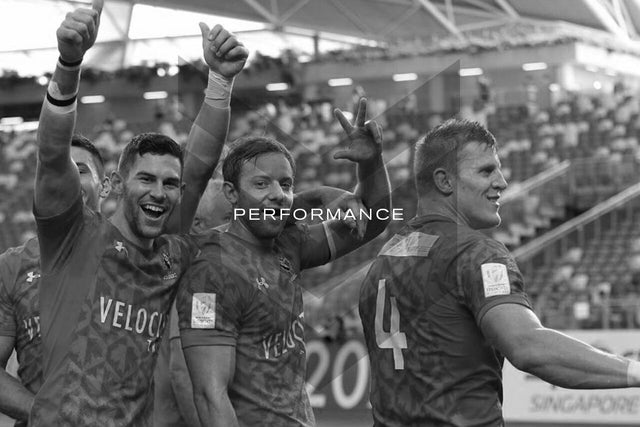Team Dynamics & Group Process: Performance
Written By: Andrea Burk
Photo Credit: Ron LeBlanc
Damian McGrath, Canada Men’s 7s coach, said it best at the BCRU Vancouver 7s Kickoff Luncheon: “Everyone played their role and played really well, together,” he recalled of the team’s first ever HSBC World Series win in Singapore in 2017.
Few experiences match that feeling where everything ‘flows’ and the team reaches a state of true performance. Resolution was about acceptance of perspectives and strengths through which comes group cohesion.
Performance is the direct result of this way of being and leads to higher functioning roles and the awareness of how to play the game in front of you.
The tricky thing about this phase is that “performance is the one thing you don’t practice specifically. It comes as a result of all the off-field preparation and on field training… I spend an inordinate amount of time on the fundamentals because they are the foundations of performance,” says McGrath.
What does performance look like? Feel like?
In the Performance Stage, people feel open and comfortable with their contribution; they feel fully supported and safe. They are no longer restrained by fears or facing the consequences of mistakes and deselection. In the physical sense of rugby this can have huge positive outcomes on the field. Imagine playing from instinct - where the answer to beating opposition or regaining possession unveils itself without even (consciously) thinking about it. Players like Ashley Steacy, Nate Hirayama, Ghislaine Landry, DTH van der Merwe, Julianne Zussman, Harry Jones, Magali Harvey and Adam Kleeburger, to name a few, have all displayed this style of play throughout their international careers.
In the context of the Singapore Sevens Cup win, think Lucas Hammond’s line that cut up the defence for the winning try. It seemingly came out of nowhere; back up the play a few frames earlier and Isaac Kay creates a seemingly impossible, yet entirely instinctual, turnover to regain possession for Canada.
 This can be described as a state of flow, harmony or mastery. This doesn’t mean it is physically easy per se, but there tends to be a huge sense of fulfillment attached to it. A good descriptor is that performance feels like a sense of freedom and empowerment. Freedom to be, and freedom to play.
This can be described as a state of flow, harmony or mastery. This doesn’t mean it is physically easy per se, but there tends to be a huge sense of fulfillment attached to it. A good descriptor is that performance feels like a sense of freedom and empowerment. Freedom to be, and freedom to play.
What can be expected from players and other group members?
Like all phases, performance happens on both micro and macro levels, like a Saturday game, a national championship or a World Cup. Performance also happens on an interpersonal level, as in how the team is functioning, and on an intra-personal level, as in how an individual player is functioning mentally and emotionally.
Group members are willing to face upcoming challenges and do so with a positive attitude. This period is high-energy and the group is almost self-sufficient. This results from the inherent sense of sel- trust and trust within the group
Watch for validation and recognition of unique member skills and roles. This is the time where even the people who seemed to be on the outside of the group in the early phases are brought in through recognition, jokes, reflections and stories.
What are key Performance Phase and Group Structure indicators?
Two major developmental characteristics (or indicators) are present in each phase. These are: the group’s purpose and responsibilities, and the socio-emotional stage.
The Performance Phase is marked by the emergence of solutions (i.e., on-field decisions are effective and going as planned) and unique individual roles are included and functioning together as one unit. To this point, McGrath stresses the need for putting “I” back in team if the group is going to perform at their highest level.
“The old adage is there is no ‘I in team,’ but I stress that there is and its crucial. I stress that players must have the mindset of 'I will do the little things that allow the team to play', the unspectacular, the mundane, those things the crowd and media don’t see but are crucial to success. I highlight and celebrate every game where someone has done the simple thing that was the base for something good to follow. When we won the Singapore leg of the World Series, Lucas Hammond scored the winning try. What we celebrated was the superb work at the breakdown before by Isaac Kaay that won the ball (against the odds) and allowed that try to happen. That was the major highlight of our review. Performance is built on the rock of the ‘I in Team’.”
 While all phases are important for different reasons, the Performance Phase is about getting the job done with the right people in the right place. It is effectively why so much time and effort is put into the early stages.
While all phases are important for different reasons, the Performance Phase is about getting the job done with the right people in the right place. It is effectively why so much time and effort is put into the early stages.
Leadership for Performance: What does the group (players, staff, volunteers and supporters) need? How can they be motivated?
In this phase, coaches need to show up as dependable, disciplined, and consistent leaders.
For the NSM7s, this means saying more with less. “I address the team an hour before KO. I make a few salient points and name the team to start, I don’t speak a word to the players again until half time. If you have prepared properly then the players know what to say, it's their team, they drive it forward. Success usually means your input [as a coach], whilst no less important, is less frequent because they know what to do, how to do it and most of all WHY [they are doing it],” says McGrath.
Common challenges?
There is such a thing as too much of a good thing. It is possible for teams to get stuck in a rut, or rest on their laurels, thinking the hard work is done only to be surprised by another opponent or by the challenges of a new training phase. Be aware that the job is not done - the group can still return to a place where they re-experience unrealistic hope or recurring frustration; which begs the need for the coaches and leaders to keep the team grounded and focused. This can be done by acknowledging hard work and success, while reminding the team what lies ahead.
A group’s performance can be upset by: overenthusiastic group members (for example, believing the team will win it all because they’ve won the first games of the tournament or season); mundane or boring tasks or training sessions (as a coach, keep creating to keep players stimulated and performing); experiencing the loss of group member(s) because of deselection or other events (treat these events with respect by acknowledging contributions and a reiterating of group goals – more about this next week); and, if the group does not know the time boundaries on the task or training phase, creating mental burnout. To this point, it is not sustainable to be “on” at all times. It's important to schedule downtime and de-load training when appropriate, so athletes and staff can rest, recover, and continue to perform.
To navigate these challenges it is important to come back to the Beginning. With the NSM7s, McGrath says, “My priority when I first start to work with a new team is, I explain what we are going to do, when we are going to do it, how we are going to do it, and WHY it will pay off for the team.”
How can leadership styles be adapted to meet the group's needs in pursuit of performance?
Enjoy this phase. Step back - a lot of the hard work is done, but the job isn’t over. The team is starting to operate as a high-functioning unit, yet still requires consistent and reliable messages and communication.
Be the leader that says, “We are doing what we came here to do, keep going, the job isn’t done yet!”
Acknowledge the human process and what is going on and what is to come in each stage. This will help people emotionally cope with what is going on and prepare for what is to come, allowing for better production and overall on-field performance.
Next Week: all (good) things must come to an end – The Ending Phase.
Team Dynamics & Coaching Through the Stages of Group Development:
Source: Dimock, H. G., & Kass, R. (2007). How to observe your group. (4th ed.). Concord, ON: Captus Press.


